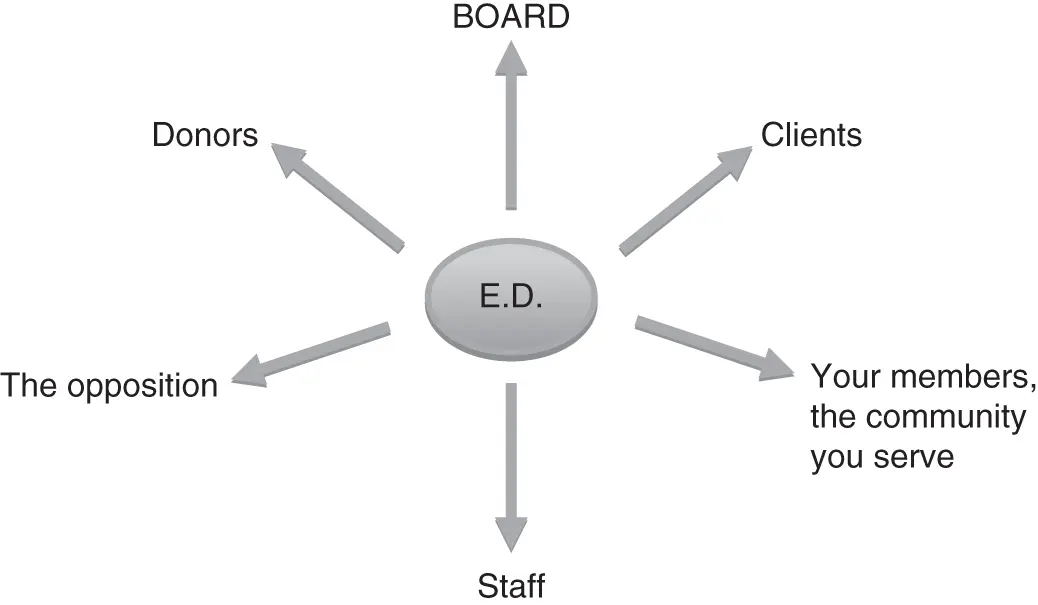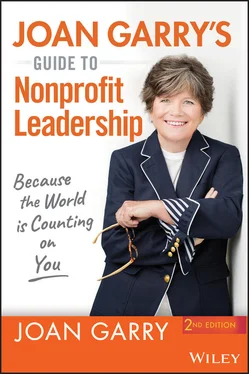She's well rounded.
Very optimistic — would lead with an optimism that her organization could change the world.
She's someone you want to be around — kind, warm‐hearted, and generous.
She has real humanity — vulnerabilities, guilt, flaws.
Another guy with some solid skills and attributes for nonprofit leadership:
A team builder, he can bring a diverse group together. Anyone who can get Gonzo, Fozzie, and Miss Piggy working toward a common goal has a real superpower.
Kermit is an optimist but not a Pollyanna. He can get down sometimes too, but in the end, he has a vision and rallies the Muppets around it.
He cares deeply about doing the right thing.
Kermit is your go‐to guy in a crisis.
Strong planning skills.
His ego is just the right size — he can and does admit mistakes.
Time to put the four of them to the test. Here's the kind of situation each of them may encounter. Then you get to make your choice.
You need a new board chair. The previous leader didn't want the job — might have been in the restroom during elections. Committees are dormant. The board does a decent job selling tickets to your big gala, but half of them don't want to pay for a ticket themselves. The founder of the organization is a big personality, and when she stepped down two years ago, she offered to join the board; and your previous board chair couldn't say no. She isn't letting go of the job. Your ED is a good performer, but the founder is driving her mad. You are worried she may be recruited away.
Who is the right person for the job?
Black Panther is the command/control nonprofit leader. The world is quite black‐and‐white for him. He would see board members as “good guys” or “bad guys”; we know it's not that simple. Nonprofit leadership demands both an understanding of and an appreciation for nuance and the land of the gray . We know this type. A good leader to dig you out fast but not the marathon guy.
Spider‐Man is a more empathetic, three‐dimensional leader. His downfall is the challenge of many leaders — insecurity .
Elastigirl? What a nice woman. Who wouldn't want to sit and hear about an organization from somebody like Helen Parr? She is a relationship builder of the highest order. But her fatal leadership flaw? She is a pleaser — a bit too flexible. Now, most nonprofit leaders have some pleaser stuff going on. But if it drives you, you are done for. You have various stakeholders, and pleasing everyone usually means pleasing no one. Your job isn't about pleasing; it's about serving your mission.
OK, so I've given the answer away.
My vote goes to Kermit hands down.
First off, Kermit would have figured out some way to give the founder a big role with no real power—look how he manages Piggy. He would rally the troops without shaming them. He would find the key strength in each board member and bring out the best in each of them. He would not be overly bossy with the ED — he'd offer his support and be more like a coach. And he would help staff and board keep their eyes on the prize, never losing sight of the organization's mission and vision.
Kermit may not thrive in a hierarchical work environment, but he'd be a rock star ED or board chair.
Kermit is not perfect, and he knows it. This trait is key to effective leadership. It makes him a good delegator! He is all about team, and he understands the value each team member brings to the work. He believes in diversity. He likes to work to reach consensus but never loses sight of the end game — he stays true to the cause. He is fair and listens, and he can manage high‐maintenance personalities without sacrificing the work. I also think he can disagree, and his team ultimately listens and respects his decisions (decisions they feel were made with their input).
Kermit understands what it takes to be a great leader in the nonprofit sector:
Understanding that power comes from all around you.
Recognizing that developing core leadership attributes is as important as skills building.
YOU'RE NOT ON TOP OF ANYTHING
In 1997, as the Executive Director of the Gay & Lesbian Alliance Against Discrimination (GLAAD), I was approached by the Coors Brewing Company. Coors was interested in making a $50,000 corporate sponsorship donation to GLAAD. As our organization was still on a financial respirator, I was interested. Very interested.
But I knew the history of Coors and the gay community — the Coors family had deep ties to the Heritage Foundation, a significant funder of organizations leading the opposition to LGBTQ equality. As a result there had been a longstanding boycott in the gay community: drink any beer you like but not Coors.
A discussion with Coors illustrated to me that the company was better on gay issues inside its organization (domestic partner benefits and other nondiscrimination policies) than many other companies who sponsored GLAAD.
Should I accept the sponsorship money and in so doing help rebuild the Coors brand in the gay community? The decision was mine to make.
Or was it?
In Jim Collins’s monograph, Good to Great and the Social Sectors: Why Business Thinking Is Not the Answer , he makes the case that power and decision‐making in the nonprofit sector are different from (and messier than) what they are in the private sector.
To be a great leader, you must erase your preconceived notions of what it means to be in charge, starting with a standard org chart like the one shown in Figure 1.1.

FIGURE 1.1 The standard org chart.
You probably have a piece of paper that shows this kind of hierarchy. Time to recycle.
Is it factually accurate? Yup. Is it how you should look at/exert your power as a nonprofit leader? Absolutely not.
So now look at the chart shown in Figure 1.2.

FIGURE 1.2 Deriving power from everyone around you.
In the org chart shown in Figure 1.1, the Coors decision is easy. I make a statement about the changes at Coors, accept the donation, make payroll, and let the chips fall where they may.
In the nonprofit sector a leader is beholden to vast and diverse stakeholders. I was hired to run GLAAD in the service of moving the needle forward on equal rights for the community I served. The bottom line matters, of course, but only to ensure that you have sufficient resources to work in the service of your mission.
In the org chart shown in Figure 1.2, the executive director derives power from all around her. This is why former Girl Scout ED Frances Hesselbein once told a reporter that she saw herself in the center and that she was “not on top of anything.”
So what did this mean for the Coors decision? The voices of the stakeholder groups around me were critical. I needed to be well‐informed, I needed strong input from different groups, and I needed a thought partner in my board chair to kick around the pros and cons. I knew the decision was ultimately mine, but I never really thought of it that way. We were all in this together.
My development director (the one I’d nearly killed — see this book's Introduction) was outraged and feared we would lose more money than we earned. We did our due diligence and determined that would not be the case. The staff was mixed — some worried I would be eaten alive by the press (given my own corporate background); others thought it was unfair to Coors when in fact by corporate standards, they were leaders.
Читать дальше














